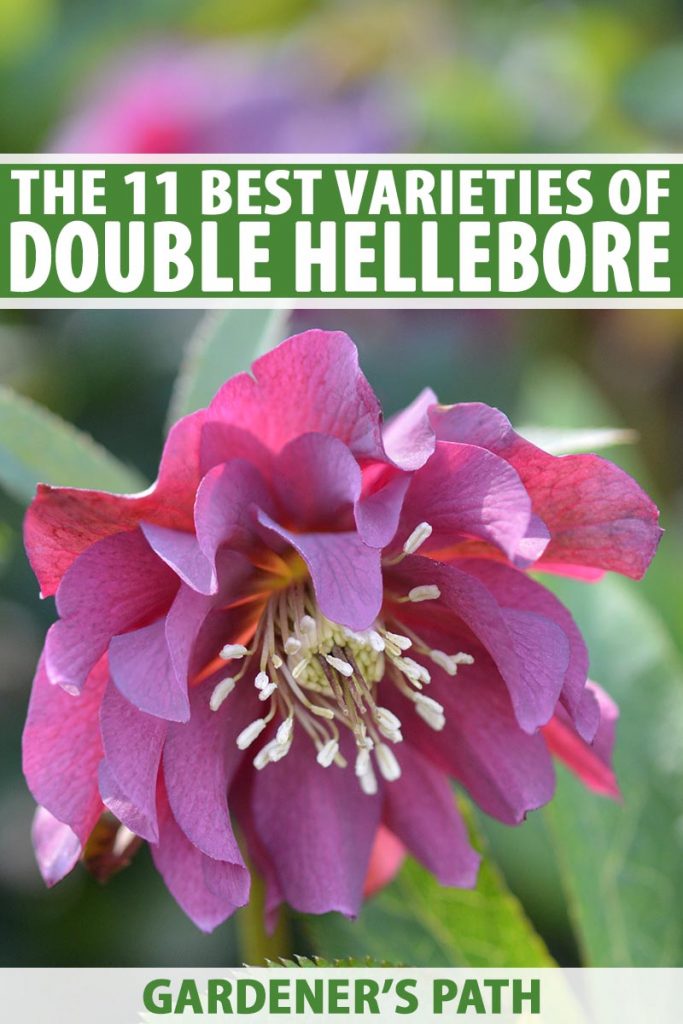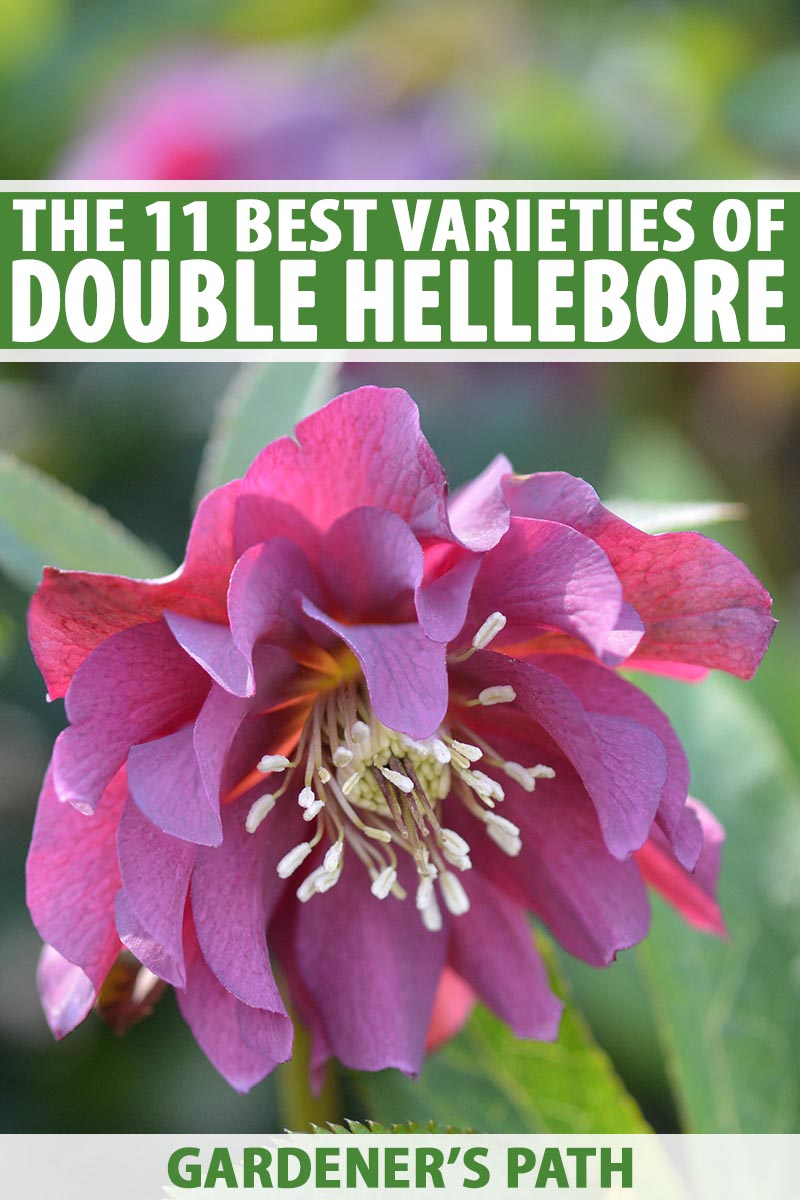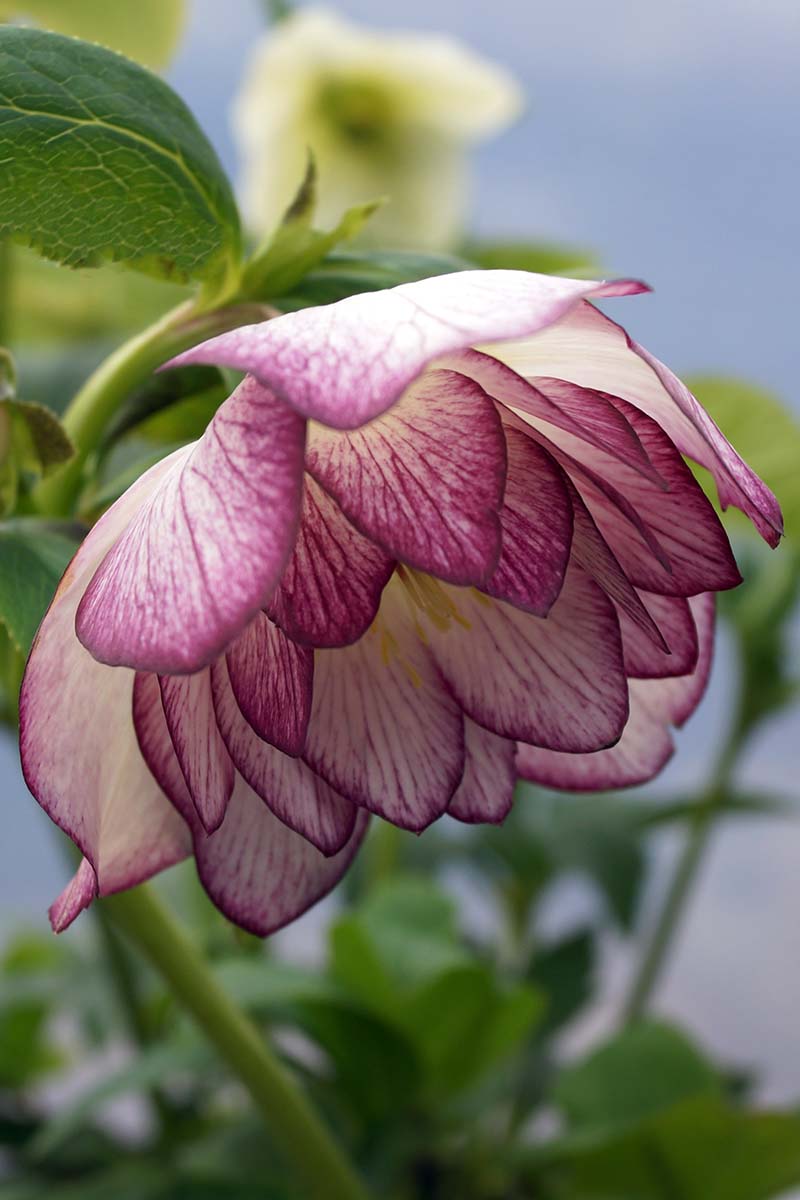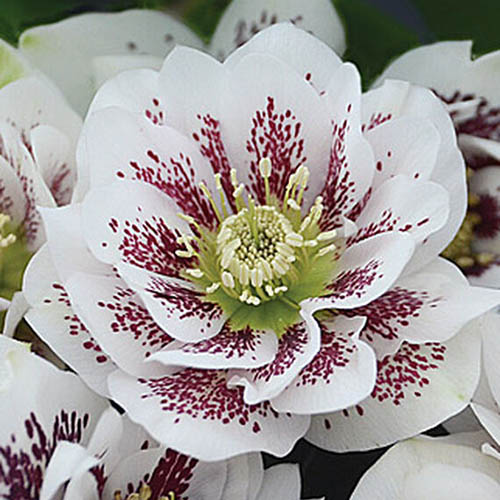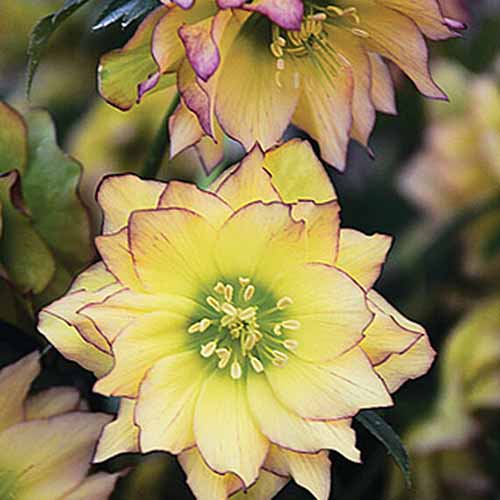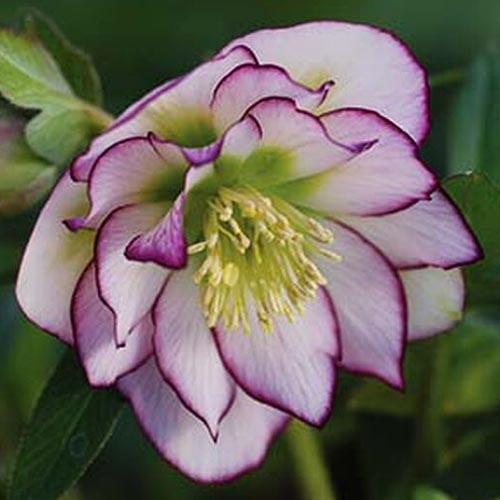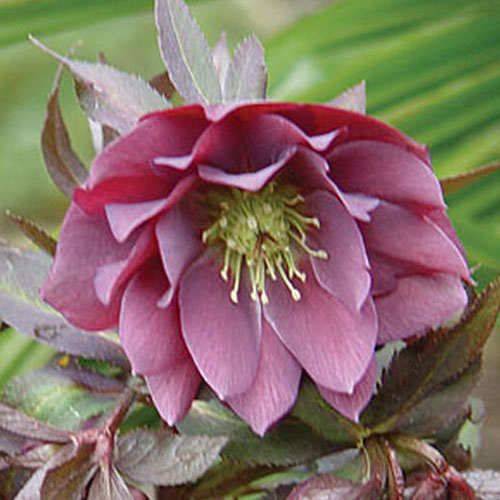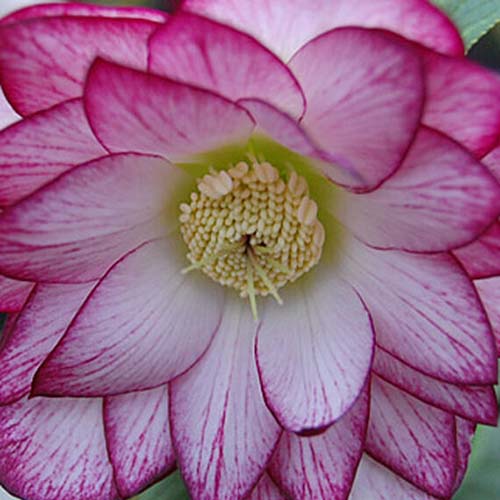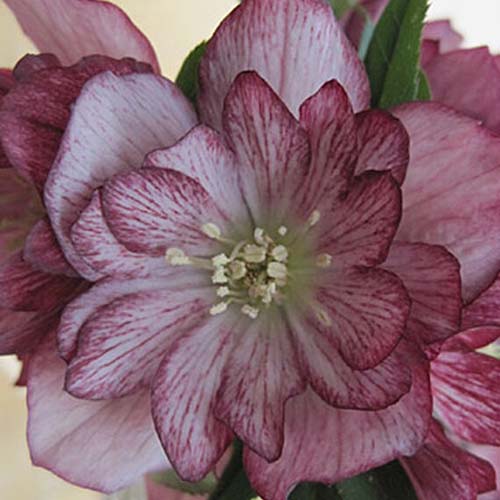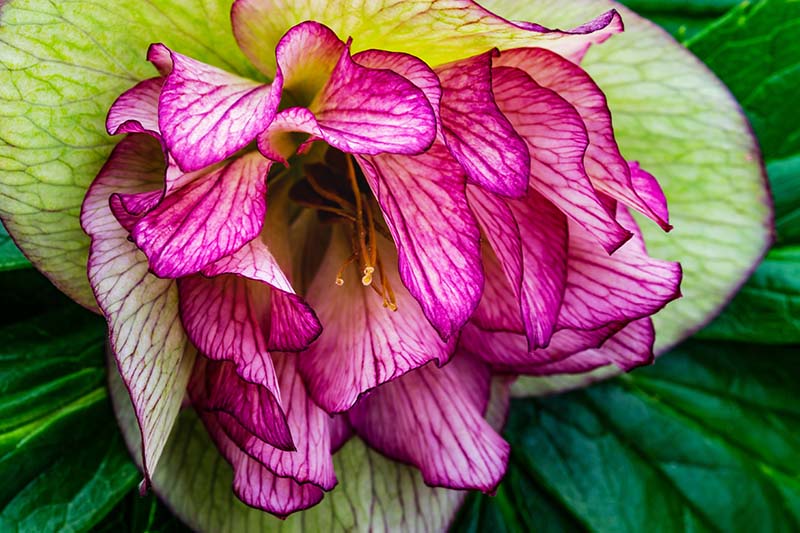Most of the hellebore varieties available to home gardeners are derived from this species, and are often referred to generically as H. x hybridus. We link to vendors to help you find relevant products. If you buy from one of our links, we may earn a commission. Many have attractive “picotee” coloring, or contrasting edges, as well as contrasting veins or speckling. However, mutations sometimes occur, in which one or more rows of petals grow and replace a portion of the nectary. This is called doubling. The result is a double hellebore with a more robust blossom consisting of an outer ring of sepals and one or more bonus inner rings of petals. And guess what? You don’t have to hope for one to randomly occur in your garden. Thanks to propagation by division and tissue culture, “double” hellebores are widely available. You may find cultivars with just one inner row of inner petals listed for sale as “semi-double,” and those with more than one row as “fully double.”
Double Hellebore Cultivars to Love
When shopping for double hellebores, you are likely to find numerous series, each with multiple selections to choose from. Each series represents the extensive cross-breeding achievements of a noted hybridizer, and offers unique flower qualities and color choices. There are also stand-alone named cultivars and unnamed mixed-color doubles with little or no information offered about their origins. You may see the descriptions “semi-double,” for hellebores with fewer petals, and “fully double,” for those with more. You can expect flower heads to be about three inches in diameter, on average. And now, here are 11 of my favorite varieties of H. x hybridus to add to your garden this season:
1. Blushing Bridesmaid
‘Blushing Bridesmaid’ is the creation of hybridizer Hans Hansen for Walter Gardens, Inc. in Zeeland, Michigan. This is one of the offerings in his Wedding Party™ series. Wedding Party™ ‘Blushing Bridesmaid’ This double hellebore offers two- to two-and-a-half-inch blossoms. Each bloom is white with dark raspberry-pink picotee edging and veining. When nodding in the late-winter garden, the sepal and petal undersides are a vibrant saturated raspberry color. Mature dimensions for this plant are 18 to 24 inches tall, and 24 inches wide. Find Wedding Party™ ‘Blushing Bridesmaid’ plants now, available at Burpee. Note: Burpee refers to this selection as ‘Bridesmaid.’
2. Confetti Cake
‘Confetti Cake’ is another variety in the Wedding Party™ series by Hans Hansen. Wedding Party™ ‘Confetti Cake’ Its flowers range from two and a half to three inches in diameter. Each has a pale green center with white petals accented by burgundy speckles. The sepal and petal undersides are white. Expect this plant to reach a height and width of between 18 and 24 inches at maturity. Find Wedding Party™ ‘Confetti Cake’ plants now from Burpee.
3. Cotton Candy
‘Cotton Candy’ is a double hellebore from the Winter Jewels® series developed by Marietta and Ernie O’Byrne of Northwest Garden Nursery in Eugene, Oregon. Winter Jewels® ‘Cotton Candy’ The blossoms of this variety are of average size with colors ranging from pale pink to cotton-candy pink. Slightly deeper colored picotee edging and veining may be present. Nodding sepals and petals are pink, some with deeper pink veining. This is a shorter plant, with a height of 12 to 14 inches and a spread of 24 inches at maturity.
4. Fire and Ice
‘Fire and Ice’ is another Winter Jewels® series beauty from Marietta and Ernie O’Byrne. Winter Jewels® ‘Fire and Ice’ The crisp white blossoms of this variety measure a showy three to four inches across. Blooms have striking reddish-pink picotee edges and minimal veining. The undersides of the sepals and petals are the same. Expect a height of between 18 and 22 inches and a spread of 24 inches at maturity.
5. First Dance
‘First Dance’ is a Wedding Party™ series selection by Hans Hansen for Walter Gardens, Inc. Wedding Party™ ‘First Dance’ Extra-large flowers measure between three and three-and-a-half inches across. Each is a lovely shade of yellow, ranging from light to bright. Edging and veining are maroon, and the typically greenish center “eyes” are prominent. The nodding blossoms show sepal and petal undersides of yellow with maroon-tinged tips. Expect a mature height of 18 to 24 inches and a spread of 24 inches. Find Wedding Party™ ‘First Dance’ plants available from Burpee.
6. Florence Picotee
‘Florence Picotee’ has warm white blossoms of average size with magenta picotee edging and veins. ‘Florence Picotee’ The nodding blooms show the undersides of sepals and petals with the same color scheme. This is one of the shorter plants, with mature heights ranging from 12 to 18 inches, and a spread of 16 to 24 inches. You can find ‘Florence Picotee’ plants available at Burpee.
7. Jade Tiger
‘Jade Tiger’ is another beautiful selection in the Winter Jewels® series developed by hybridizers Marietta and Ernie O’Byrne. This variety sports chartreuse blossoms of average size, with maroon accents that include picotee edging and streaking or spotting. Nodding heads are predominantly chartreuse. Mature heights reach between 12 to 18 inches. Plants spread from 18 to 24 inches.
8. Kingston Cardinal
‘Kingston Cardinal’ was developed by horticulturist Daniel Hinckley, founder of Heronswood Nursery (that was later bought by Burpee) in Kingston, Washington, and Windcliff in Indianola, Washington. ‘Kingston Cardinal’ This cultivar produces average size, deep raspberry-red flowers. The single tone creates rich color saturation of both the face and nodding head of each blossom. Its most unique characteristic is that it is fully sterile, so there will be no self-seeding, and you can’t save the seeds. This variety tops out at 22 to 26 inches tall and wide. You can buy ‘Kingston Cardinal’ plants from Burpee.
9. Peppermint Ice
‘Peppermint Ice’ is a Winter Jewels® series selection from hybridizers Marietta and Ernie O’Byrne. Winter Jewels® ‘Peppermint Ice’ Soft pink blossoms have fuchsia picotee edging and veining in both the faces and undersides. This variety is known for retaining its pink hue well into the seed setting stage, when others fade to brown. This is a shorter stature plant with mature heights that range from 12 to 18 inches, and a 20- to 24-inch spread. Winter Jewels® ‘Peppermint Ice’ plants are available from Burpee.
10. Phoebe
‘Phoebe’ resembles a tissue paper rose. Colors range from blush to bright pink, and the inner petals are especially frilly. ‘Phoebe’ Both petals and sepals are dotted with deep pink speckles for attractive contrast and depth. The gently nodding heads of this cultivar are soft pink when viewed from above. The mature dimensions of the plant are 18 to 24 inches tall and wide. Find ‘Phoebe’ plants for your garden now from Burpee.
11. Stained Glass
‘Stained Glass’ has reddish-purple veining and picotee edging, making it one of the darker blossoms. ‘Stained Glass’ The overall color lightens during the growing season, further accentuating the dark edging. The undersides of the blossoms are a saturated reddish-purple that is especially vibrant in the garden. At maturity, this plant may reach a height of 18 inches and a width of 22 to 26 inches. Find ‘Stained Glass’ plants now from Burpee.
Twice as Nice
The Helleborus genus offers so much to the home gardener who wants to liven up the late winter garden. And thanks to the work of hybridizers, a once random treat of nature – the double hellebore – is now readily available. With 11 of the best selections to choose from, all you need to do now is decide where to plant your new favorites. They are the perfect companions for other late winter and early spring flowers, like the crocus, daffodil, grape hyacinth, and snowdrop. Mix or match as you like to fill in an existing landscape scheme, or design an entirely new one. Have you made your garden twice as nice with the robust blossoms of double hellebores? Let us know in the comments below. For more information about growing hellebores in your garden, check out these guides next:
How to Collect Hellebore Seeds for Plant PropagationHow to Divide and Transplant HelleboresHow to Grow Hellebores, the Winter-to-Spring Sensation
